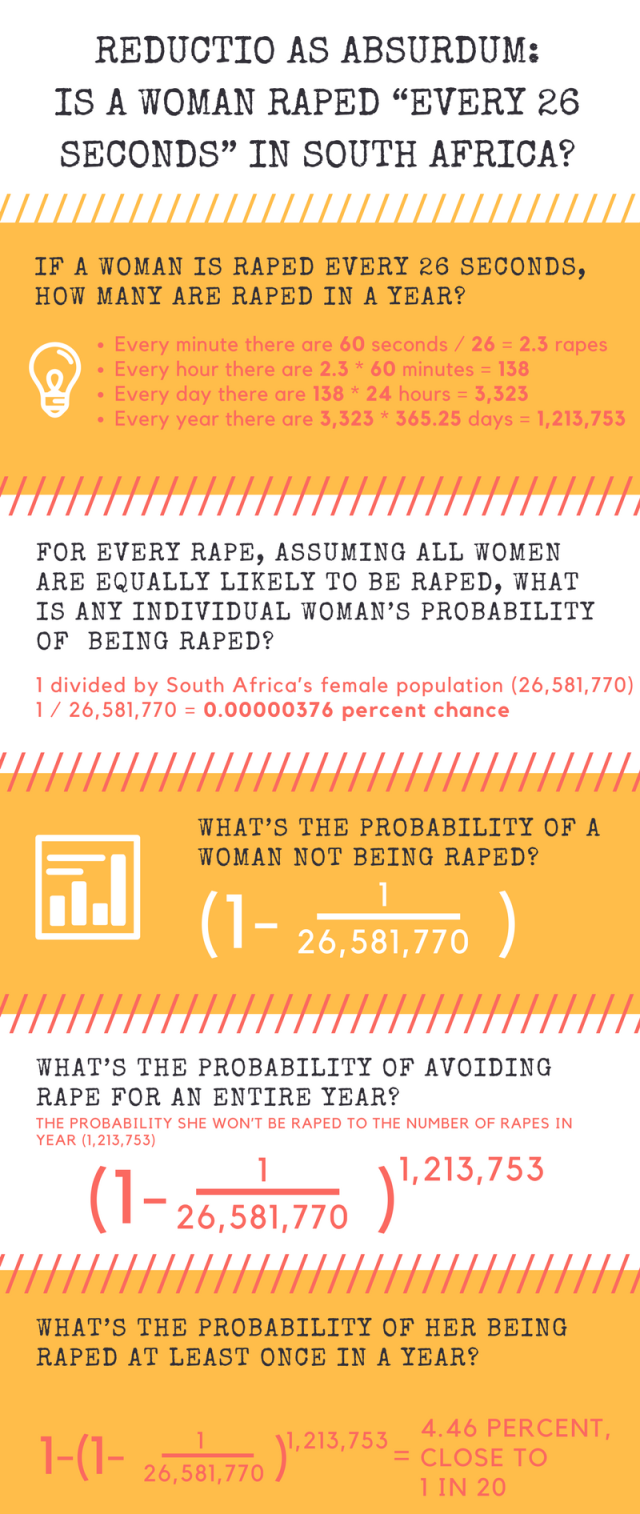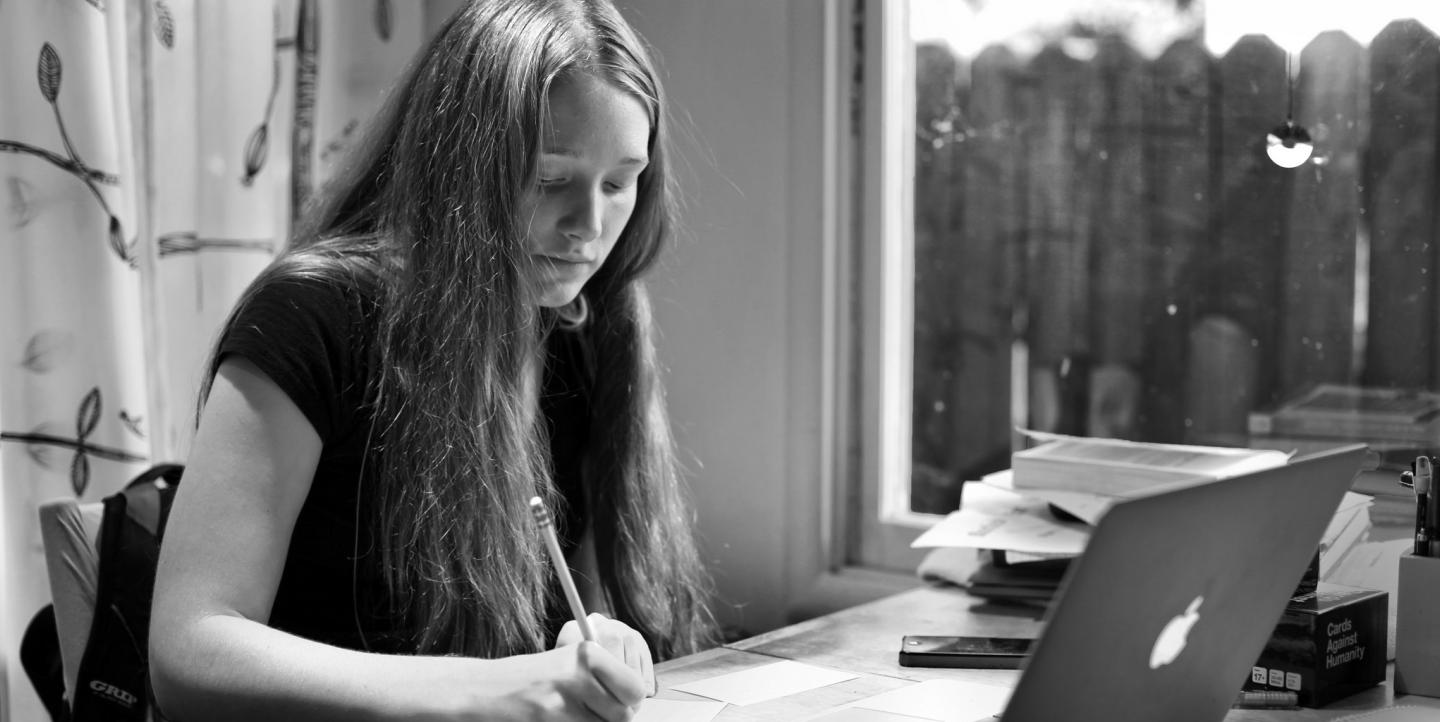In the post-truth era where facts are often manipulated or just plain made up, a wide range of fact-checking organizations have sprung up around the world.
Fact-checkers typically use data, photos, crowdsourcing and other techniques when working to verify something. I would like to suggest an additional tool in the truth-seeker’s toolbox: reductio as absurdum — assume the claim is true, and follow it to see where you end up. Besides challenging false claims, this type of argument has an added benefit of producing interesting conversations at cocktail parties.
A good example is this excellent piece from 2016, in which AfricaCheck examined the infamous and often-quoted statistic that "a woman is raped every 26 seconds in South Africa." This number has been circulating for many years, often attributed to the United Nations.
Based on this figure, a quick calculation reveals South Africa would experience 1.2 million rapes annually, an incredibly high number for a country of 51 million people, according to the 2011 census.
AfricaCheck’s sleuthing revealed the Rape Crisis Center as the original source of the “26 seconds” estimate. (To be fair, the Rape Crisis Center has long been misquoted, as their original calculation included rape of both men and women). Fact-checking the same story, BuzzFeed performed some impressive internet archeological research and found this awkward 1999 advert, featuring actress Charlize Theron decrying the statistic and what it implies about South African men.
So I thought it worthwhile to try my hand at debunking the figure using a different approach. Before I start though, a caveat: South Africa does experience very high levels of sexual violence. Rape is a sensitive topic — however, this article deals with statistics, and numbers by their very nature dehumanize people. I’m aware that I risk sounding callous in this article. However, my intent is to encourage critical thinking and hopefully demonstrate how other journalists can use simple math and reductio as absurdum as a way to debunk false assertions.
(For those interested in following along with the math in greater detail, check the addendum at the bottom of this article).
The claim is that a woman is raped every 26 seconds in South Africa. This works out to 2.3 rapes per minute, which leads us to 138 rapes per hour, which leads to 3,323 rapes per day. With 365.25 days in a year, we end up with 1,213,753 women raped in South Africa per year.
Those are seriously high numbers. According to the 2011 South Africa census, there were 26,581,770 women in the country.
Given these numbers, what is the likelihood of any individual woman being raped in a given year? To calculate this, we need to assume that at any point in time, all women are equally likely to be raped. In other words, we don’t take into account the level of crime in an area, socioeconomic status, age, or any other possible factor that may make the rape of one women more likely than any other.
So if there are 26,581,770 women in South Africa, we can calculate their likelihood of being raped in a given year by dividing one by that number — 0.00000376 percent.
But remember, we’re working on the assumption that there are over 1.2 million rapes annually. What is the probability of a woman avoiding rape for an entire year? Do the math and we end up with 4.46 percent. That’s close to one in 20, and is pretty much the gist of the Rape Crisis Center calculation.
What if we look at this over a longer period of time? What is the probability of a South African woman being raped at least once in 10 years? The calculations below take us through various years:
| Age of a South African woman | Likelihood that she will one day be raped in South Africa |
|---|---|
| 1 | 4.46 percent |
| 10 | 36.6 percent |
| 20 | 59.8 percent |
| 30 | 74.5 percent |
| 40 | 83.9 percent |
| 50 | 89.8 percent |
| 58.83 | 93.18 percent |
In other words, over the course of an average South African woman’s lifetime, she has a 93.18 percent chance of being raped. That’s an incredible claim.
While it’s clear that sexual violence is a serious problem in South Africa, the “26 seconds” number seems exaggerated. The rationale behind the Rape Crisis Center estimate is that very few women actually report rape — thus, the Center estimates that only one in 20 does. While my calculations haven’t disproved their assumptions, it does cast some doubt over the veracity of their claim.
As we know, statistics are often used to make claims based on estimates. As journalists, we shouldn’t always accept them at face value. It’s worth taking a skeptical approach and interrogating numbers which make overly bold statements.
Both AfricaCheck and BuzzFeed went a long way toward debunking the “26 seconds” statistic. I was also able to do more or less the same simply by doing the math myself. Fact-checking doesn’t always have to be fancy — a back-of-an-envelope, pencil-and-paper approach can also go a long way when testing how well certain claims stand up to scrutiny.
Adi Eyal is the founder of Code for South Africa. Learn more about his work as an ICFJ Knight Fellow here.

Main image CC-licensed by Flickr via Robert Couse-Baker. Infographic produced by Sam Berkhead.

